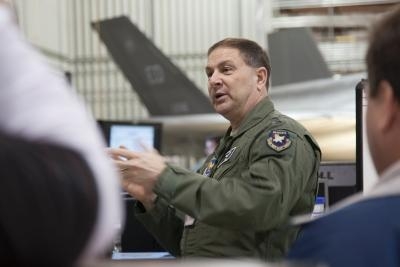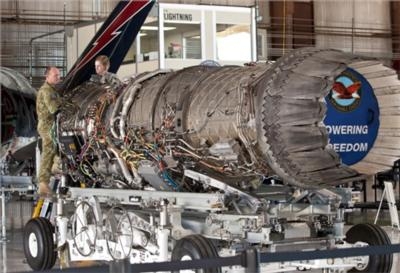Some Potential Solutions Being Tested By Pratt & Whitney, Official Says
Air Force Lt. Gen. Christopher C. Bogdan, the head of the F-35 Lightning II joint strike fighter program office, said by the end of December he expects to have decided on a permanent solution for a design issue that caused an F-35A engine to fail in June at Eglin Air Force Base, Florida.

The engine's manufacturer, Pratt & Whitney, has offered several potential fixes, some of which already are being tested, Bogdan (pictured) told reporters Oct. 30.
The engine failure and subsequent fire were the result of micro fractures in one of the three-stage fan sections that compress air before it enters the engine, the general said. These sections are lined with a polyimide material that is designed to rub against the fan blades to reduce pressure loss.
In the case of AF-27, the third fan rubbed in excess of tolerance during maneuvers several weeks before the failure, causing the blades to heat to about 1,900 degrees -- 900 more than ever expected, Bogdan said. This led to micro fractures in the titanium part of the rotor, which grew over the next few weeks of flying before finally failing.
"That caused that rotor to liberate from the airplane," Bogdan said. "The fire was caused not by the engine, but by the pieces of the engine that flew out through the aft upper fuselage fuel tank."
The fire led officials to ground the aircraft July 3 for fleet wide engine inspections. The aircraft returned to limited flight July 14 when no systemic issues were found, defense officials said.
"Two short mid-term fixes have already been validated," Bogdan said.
For the first, a new engine is flown in a defined profile that subjects it to a specific set of altitudes, airspeeds, G-forces and roll rates, he said.
"In two sorties, you can burn in the engine in a very controlled way," the general said, "such that where this rubbing occurs has now been burned in, so to speak, and anything else you do with the airplane inside the envelope won't cause any more rubbing than what it has already seen."
This burn-in process already has been conducted on four of the Air Force's test aircraft, he said. The procedure takes about an hour for each sortie, and the engine is inspected after each flight. If the engine passes the second inspection, the airplane is cleared for flight within its "normal full envelope," Bogdan said.
"We've done that on four test airplanes already, validated it. It's working (and) we plan on using that on the test airplanes over the next few weeks," he said.
The second method involves a change to the manufacturing process of the engine, the general said. Instead of designing the blades to rub on the polyimide lining of the stator walls, the lining would be "pre-trenched," Bogdan said.
"When we put the fan blade in there, no matter what we do on the airplane G-wise, speed-wise, altitude-wise, it won't rub anymore," the general said.

The new design already has been flight-tested on AF-2 and AF-4, which are developmental testing jets.
"As it turns out, that solution works very, very well," Bogdan said. "We inspected the engine and we saw no signs whatsoever of any rubbing at all, not even normal rubbing that we see, which leads us to believe that we can fly through the full envelope of the airplane and not have any of that heating anymore."
All 19 developmental testing aircraft will have undergone either the burn-in or pre-trenching retrofitting by the end of December, the general said, noting that the team is working with Navy and Air Force airworthiness authorities to approve the process for the more than 100 already-fielded F-35s. Pratt & Whitney is bearing the cost of retrofitting or burning in all of the fielded engines, Bogdan said.
It will take months to complete the fixes for all of the fielded airplanes, he said. Two methods were needed because fabricating a set of new stators takes a week.
"So if we just went with that method alone," he said, "it would take us quite a while to replace all the engine fan sections of the fielded airplanes ... With the rub-in procedure, we can start getting to the same result by flying those airplanes through the burn-in. That's why it's important to get both those solutions out there."
Pratt & Whitney has presented several options for a long-term solution to the issue, Bogdan said:
- Change the polyimide material to one that can handle more heat
- Treat the tips of the titanium fan blades to withstand more heat
- Pre-trenching
- Some combination or combinations of the above
"We are going to take our time, and it probably won't be before the end of (December) where the enterprise -- and when I say enterprise, I mean the Navy, the Air Force (and) my engineering team -- get together and decide what is the best option for production cut-in," he said.
Whatever cut-in costs are generated by re-engineering and producing the new solution for the production engines will be paid by Pratt & Whitney, Bogdan said. "We, the government, are going to pay the nonrecurring engineering portion of that, because that's the way the ... contract was built 14 years ago, and we won't go back and change that."
Bogdan said he estimates it won't be until near the end of 2015 before engines are coming off the production line with the chosen solution. Once that happens, any engines that are not in airplanes yet will be retrofitted.
(Images from file)
 ANN's Daily Aero-Linx (04.16.24)
ANN's Daily Aero-Linx (04.16.24) Aero-News: Quote of the Day (04.16.24)
Aero-News: Quote of the Day (04.16.24) Airborne 04.10.24: SnF24!, A50 Heritage Reveal, HeliCycle!, Montaer MC-01
Airborne 04.10.24: SnF24!, A50 Heritage Reveal, HeliCycle!, Montaer MC-01 Airborne 04.12.24: SnF24!, G100UL Is Here, Holy Micro, Plane Tags
Airborne 04.12.24: SnF24!, G100UL Is Here, Holy Micro, Plane Tags Airborne-Flight Training 04.17.24: Feds Need Controllers, Spirit Delay, Redbird
Airborne-Flight Training 04.17.24: Feds Need Controllers, Spirit Delay, Redbird




